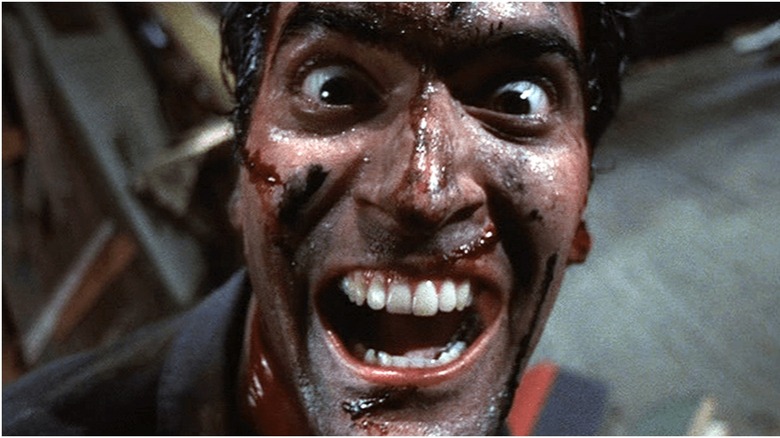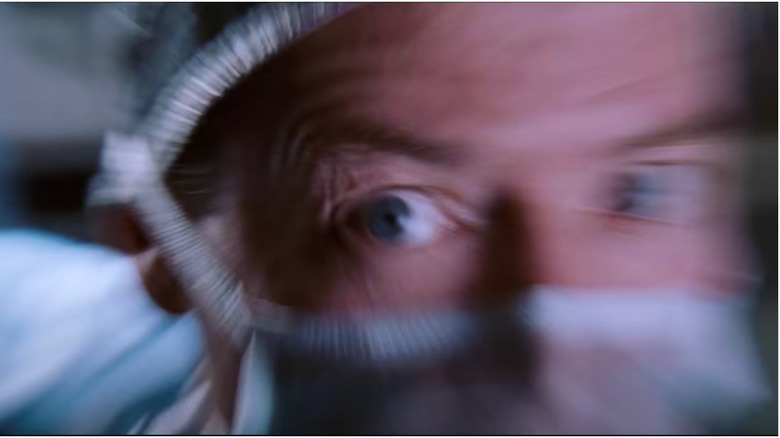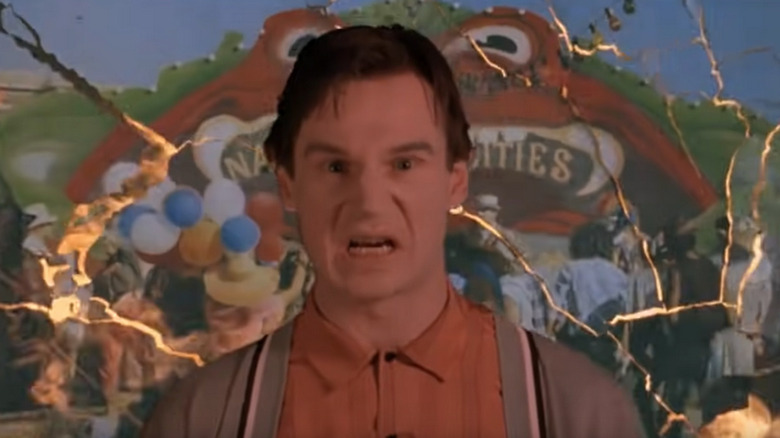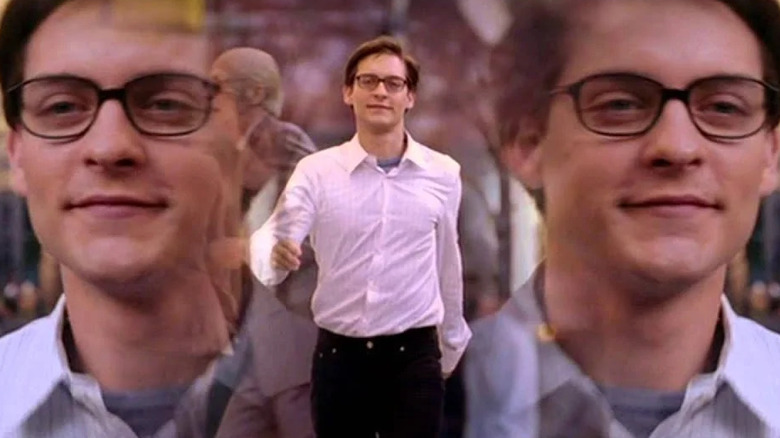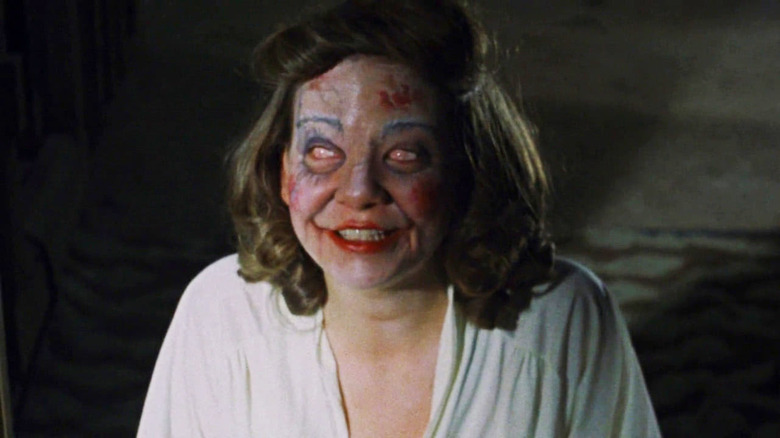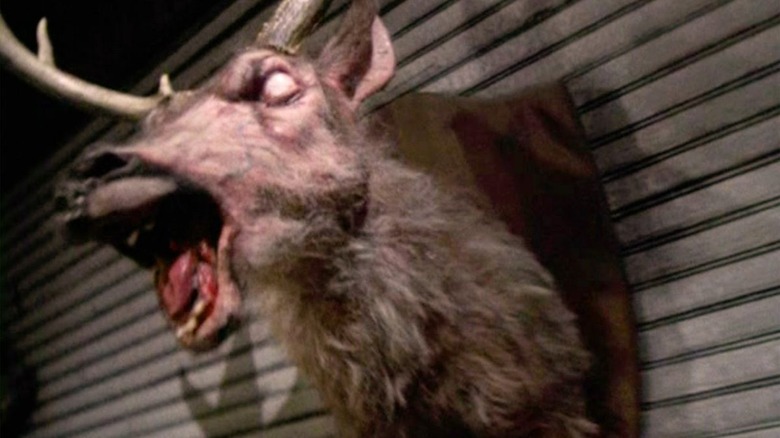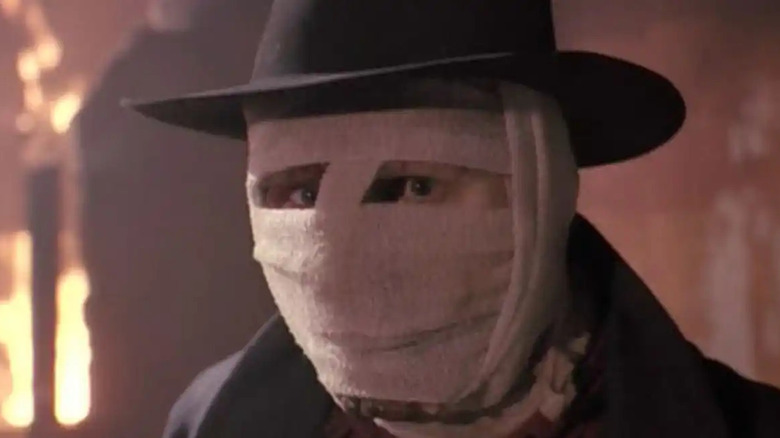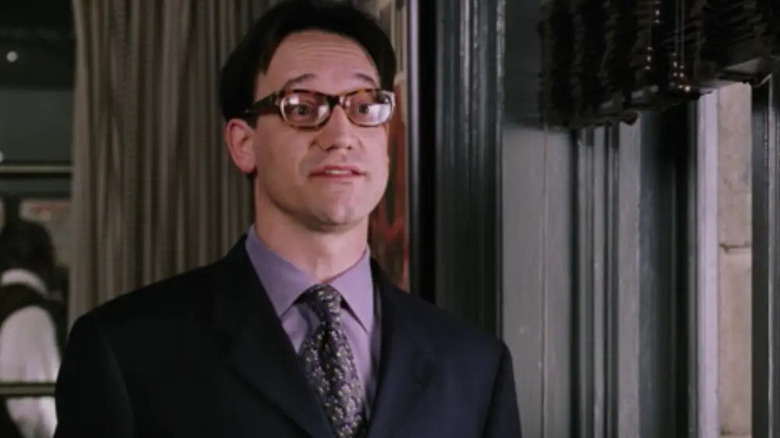What Exactly Makes A Sam Raimi Movie A Sam Raimi Movie
The king has returned! (Hail to the king, baby). After a nine-year hiatus from directing feature films, Sam Raimi returned to directing with "Doctor Strange in the Multiverse of Madness" and delivered what might be the best-directed movie in the Marvel Cinematic Universe while reminding us what we'd been missing during his sabbatical.
So, what exactly is it about Sam Raimi movies that makes them so unique? Why is his style so evident in any given moment from any of his films, even his superhero work? As with any auteur, if you look across his work, you'll see patterns both in the types of stories Raimi tells and how he chooses to tell those stories.
Camera movement
One of Raimi's absolute favorite camera tricks is a lighting fast zoom-in, usually into a character's eye. Once the camera gets as extreme as a close-up as can be, the scene will smash cut to a wide shot of the impact. The scene gets the subjectivity of the character about to be hit but unable to move away in time, and then the objectivity of what happens when they are hit.
One of Raimi's greatest uses of this is in "Spider-Man 2," specifically the Doc Ock (Alfred Molina) surgery scene. The lead surgeon spots a looming tentacle and when he turns around, it lunges. The camera zooms into the doctor's eye at a lighting-fast pace before cutting to a wide shot of the tentacle knocking its target across the room. Similarly, in the climax of "The Quick and the Dead," Ellen (Sharon Stone) shoots the shot that ends John Herod (Gene Hackman). The camera follows the bullet's POV as it enters Herod's eye and then smash cuts to a wide shot as he goes flying.
Raimi often uses handheld first-person POV, especially in the "Evil Dead" trilogy, where such shots are employed to show the world through the evil Deadites' eyes. The first movie famously ends with an unseen monster tunneling through the woods, into the cabin, then lunging at Ash, all seen through its eyes.
Raimi also loves his whip pans. In the bank robbery scene of "Spider-Man 2," when our hero (Tobey Maguire) is in Doc Ock's grasp, the shot cuts to Spider-Man's left hand. When he launches a web, the camera whip pans to a table, arriving on its new subject as the web makes contact. This camera movement repeats as Spidey webs a second table to his left before slamming them both into the villain.
Framing
Raimi loves to move his camera, but when he wants to hold on a shot, how does he frame it?
Oftentimes, with Dutch angles, aka, shots that are canted or askew. In the "Evil Dead" trilogy, Dutch angles are Raimi's go-to method for signaling the presence of Deadites and framing close-ups of the horrified characters. Raimi is willing to go Dutch just for a cool image though; take an early shot in "Evil Dead II" when Ash (Bruce Campbell) buries his girlfriend Linda (Denise Bixler). As Ash marks the burial with a make-shift cross, his whole body is visible while the camera sits on a low, tilted angle. This shot is recreated in the sequel "Army of Darkness" when Ash buries his evil self. During the seance scene in "Drag Me To Hell," Raimi likewise uses a Dutch angle while the demonic Lamia leers over Christine (Alison Lohman).
"Darkman," Raimi's first foray into superheroes, features his most disorienting use of titled framing. Peyton Westlake (Liam Neeson) is afflicted with heightened anger after an accident leaves his face horribly burned and his nerves severed. When he's denied a carnival prize for his girlfriend Julie (Frances McDormand), he flips. Peyton is shot with Dutch angles and in extreme close-ups while Julie is shot on an even axis from a medium close-up, emphasizing his over-the-top anger.
Raimi will also have his characters look into the camera, not to break the fourth wall, but to emphasize their reaction. One of the most famous shots in "Evil Dead II" is a close-up of a bug-eyed, blood-splattered Ash grinning maniacally as he looks straight ahead. The aforementioned "Darkman" scene climaxes with an enraged Peyton, fire erupting at his sides. Raimi combines this glare with his eye zoom, zooming in through Peyton's left eye and then pulling back through his right.
Montage
With how much mileage Raimi gets out of moving his camera, it shouldn't be surprising that he also loves a good montage. In "Spider-Man 2," after Peter quits super-heroics, the film shifts to a montage of him enjoying everyday life. Peter walks through the city carefree and catches up on his studies, all set to B. J. Thomas' "Raindrops Keep Fallin' On My Head" (the same song which played under a similar downtime montage in "Butch Cassidy and the Sundance Kid"). During this sequence, Raimi uses whip pans not within a single scene, but as transitions from one moment to another.
Raimi's first "Spider-Man" also used a montage for the scene where Peter designs his costume. This sequence exemplifies Raimi's preferred editing style, mixing cross-fades and overlays to show multiple subjects on the screen at the same time. When Peter first sees the ad for a wrestling competition, Raimi makes sure the audience knows exactly what's on his mind by placing a double exposure of Mary-Jane (Kirsten Dunst) next to Peter's head.
"The Quick and the Dead" has the best-constructed montage of all, showing the progress of the gunslinging competition. As duelers (set against a black background) kill or fall, the sequence intersperses close-up reactions from the main players, shots of the town clocktower, and a chalk whiteboard keeping tracking of the dead.
One of the best scenes in "Multiverse of Madness" is one of these cross-fade montages. Exposition typically grinds Marvel movies to a halt, but Raimi keeps the pace moving by emphasizing visual impact as much as the dialogue.
Horror
Now that we've explored how Raimi makes a movie, let's look at the types of movies he likes to make. First up: horror, the genre where Raimi cut his teeth. Even looking past "Evil Dead," the most memorable moments in his blockbusters are the ones with a scary edge to them. "Spider-Man" uses a jump scare when the Green Goblin attacks Aunt May and the fiery atmosphere of the scene mixed with Willem Dafoe and Rosemary Harris' pitch-perfect performances of malevolence and terror, respectively, make the scene genuinely scary in ways modern superhero movies don't approach.
Raimi isn't shy about gore either. "The Evil Dead" is a straight-up grindhouse splatter movie; the concluding minutes of the film are taken up mostly with shots of the Deadites dissolving in gruesome detail. The sequels don't tone this down — both "Evil Dead II" and "Army of Darkness" have scenes of blood erupting like a geyser.
As Raimi told Den of Geek, the first horror movie he ever saw was George Romero's "Night of the Living Dead":
"I'd never experienced horror like that before. It felt so real, like a docu-horror. I had never seen a black-and-white movie in a movie theatre before; it looked like a documentary. There was nothing Hollywood about it – it was just unrelenting and complete madness and very upsetting for me."
The influence on Raimi is obvious: both "Evil Dead" and Romero's film are about the protagonists trapped in remote houses, besieged by the undead. Before the sequel introduces his chainsaw, Ash wields a shotgun, the same weapon used by Ben (Duane Jones) in "Night of the Living Dead."
Slapstick
What makes Raimi's horror movies stand out is that they're not just scary, but also funny. It did take him some time to mix these seemingly opposite tones, though. "The Evil Dead" is horror exploitation played straight, a lowbrow "Exorcist" with the setting and grime of "The Texas Chainsaw Massacre." His second film, "Crimewave," aims for slapstick but falls on its own face, winding up not as a thriller comedy but a farce.
It's in "Evil Dead II" where Raimi is able to bridge his comedy and horror instincts for what's best described as "scary slapstick." The opening half of "Evil Dead II" is just Bruce Campbell's Ash stumbling through the cabin and being tormented by everything from a headless, reanimated Linda to his own hand. The imagery is scary, but the effect is comic.
Raimi and Campbell are both fans of "The Three Stooges," and this fandom bleeds over into the slapstick of "Evil Dead." According to Campbell, the scene of a lightbulb filling with blood then exploding is a nod to his favorite "Stooges" short, "A Plumbing We Will Go." One of Raimi's own favorite "Stooges" shorts is "Brideless Groom," featuring a scene where Moe accidentally bites his own hand. It's not hard to see this as the inspiration for all the trouble Ash goes through with his right hand in "Evil Dead II."
One of Raimi's go-to physical comedy moves is to send characters flying through the air, defying gravity like they're in "Looney Tunes." In "Darkman," Peyton frames one of Robert Durant's (Larry Drake) henchmen for stealing from the till, leaving stolen money and airline tickets in his apartment. Durant tells his seemingly treacherous henchman, "Have a nice flight." Smash cut to him plummeting out the window.
Character archetypes
Raimi has a thing for mad scientists straight out of Universal Horror films — the Green Goblin and Doc Ock fit the bill, while the blue-collar Sandman is still the product of science gone wrong. "Darkman," which is not the best Sam Raimi movie but may be the most Sam Raimi movie, flips the script by making the mad scientist the hero. Darkman's costume evokes the bandaged face of the Invisible Man (but with the black trench coat and hat of The Shadow).
Raimi's protagonists usually face ostracization; even his most privileged ones are down on their luck. Raimi explained the appeal of Peter Parker:
"The great strength of Spider-Man is the fact that he's a real person, he's one of us, he's a kid from Brooklyn who doesn't have a lot of money, he doesn't get the girls, he's got acne, he's a fairly average looking kid... he's one of us unlike Superman from the planet Krypton and other fantastic heroes. He's really a kid that we identify with."
Another character type that crops up is the doppelgänger. The villain of "Army of Darkness" is Evil Ash, also played by Campbell. In "Darkman," Peyton disguises himself as Durant and comes face-to-face with the real thing. This makes Raimi's antipathy towards Venom a bit surprising, but it does explain why Eddie Brock (Topher Grace) in "Spider-Man 3" is just an evil Peter Parker.
Recurring collaborators
Raimi has a regular team of actors and behind-the-camera crew that he employs again and again. Most obviously, there's Ash Williams himself, Bruce Campbell. Campbell cameos in almost all of Raimi's movies, from appearing as Darkman's final disguise to his three distinct appearances in every "Spider-Man" movie.
Raimi also makes filmmaking a family effort. His younger brother Ted acts in many of his movies, most notably as Daily Bugle ad manager Hoffman in the "Spider-Man" trilogy. His older brother Ivan (who works primarily as a physician) has screenplay credits on "Darkman," "Army of Darkness," "Spider-Man 3," and "Drag Me To Hell."
Composer Danny Elfman has worked on seven of Raimi's 15 films; his operatic music fits Raimi's heightened tone. Raimi's usual directors of photography are Bill Pope or Peter Deming, while his usual editor is Bob Murawski. Raimi is also a friend of the Coen brothers and in the early days of their careers, they often collaborated.
In other words, it takes more than just Sam Raimi to make a Sam Raimi movie.
